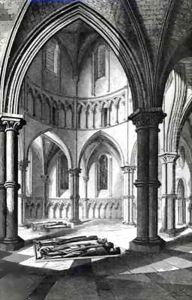R.W. Billings Paintings
Robert William Billings was an English artist, architect, and illustrator, born in 1813, whose work left a lasting impact on Victorian perceptions of Gothic architecture and historical buildings. His detailed drawings and engravings helped to popularize Gothic Revival architecture and played a key role in the 19th-century restoration movement in Britain. Billings' keen eye for detail and his ability to capture the intricacies of medieval architecture made his work invaluable for both contemporary architects and historians.
Billings began his career as an architectural draughtsman, a profession that allowed him to travel extensively across the United Kingdom, documenting ancient buildings, churches, and castles. His most notable work, 'The Architectural Antiquities of Great Britain,' published in the 1840s, is a testament to his skill as an illustrator and his passion for Gothic architecture. This work, along with his other publications, contributed significantly to the revival of interest in medieval architecture, which had been neglected in favor of classical styles.
Beyond his contributions to architectural illustration, Billings was also involved in architectural design, although this aspect of his career is less well-documented. His illustrations served not only as records of architectural history but also inspired architects and designers of his time to incorporate Gothic elements into their work. Billings' influence extended into the educational realm as well, as his books became essential reading for students of architecture and design.
R.W. Billings died in 1874, but his legacy lived on through his contributions to the Gothic Revival movement and his detailed illustrations of Britain's architectural heritage. His work continues to be celebrated for its accuracy and beauty, offering a window into the past that remains invaluable to historians, architects, and art enthusiasts alike.
